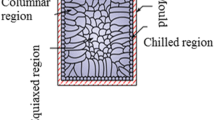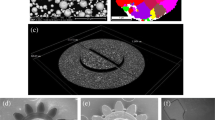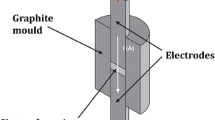Abstract
Micro-metal injection moulding process technology is one of the key technologies to satisfy the increasing demands for smaller parts associated to miniaturisation and fictionalisation in different application fields. The process combines the shape-making capability of polymer by hot embossing with sintering technology to produce complex, high density metal parts with outstanding properties. The present work focussed on elaboration and characterisation of feedstock based on 316L stainless steel powders for micro-powder embossing process. In this paper, the rheological specifications of the binder and the feedstock were observed by means of capillary rheometry. Thermogravimetric analysis was carried out on feedstock in order to understand decomposition behaviour of the binder components. The effects of sintering temperature on the dimensional stability, and particularly hardness of sintered components, were investigated. The results show that the feedstock can be used for the manufacturing of the micro-fluidic die mould cavities with a low roughness, proper dimensions and good shape retention.
Similar content being viewed by others
References
Jena RK, Yue CY, Lam YC, Tang PS, Gupta A (2012) Comparison of different molds (epoxy, polymer and silicon) for microfabrication by hot embossing technique. Sensors Actuators B Chem 163:233–241
Heckele M, Schomburg WK (2004) Review on micro molding of thermoplastic polymers. J Micromech Microeng 14:1–14
Glinsner T, Veres T, Kreindl G, Roy E, Morton K, Wieser T et al (2010) Fully automated hot embossing processes utilizing high resolution working stamps. Microelectron Eng 87:1037–1040
Heckele M, Bacher W, Müller KD (1998) Hot embossing—the moulding technique for plastic microstructures. Microsyst Technol 4:122–124
Mathur A, Roy SS, Tweedie M, Mukhopadhyay S, Mitra SK, McLaughlin JA (2009) Characterisation of PMMA microfluidic channels and devices fabricated by hot embossing and sealed by direct bonding. Curr Appl Phys 9:1199–1202
Greener J, Li W, Ren J, Voicu D, Pakharenko V, Tang T et al (2010) Rapid, cost-efficient fabrication of microfluidic reactors in thermoplastic polymers by combining photolithography and hot embossing. Lab Chip 10:522–524
Huang M-S, Chiang Y-C, Lin S-C, Cheng H-C, Huang C-F, Shen Y-K et al (2012) Fabrication of microfluidic chip using micro-hot embossing with micro electrical discharge machining mold. Polym Adv Technol 23:57–64
Kolew A, Muench D, Sikora K, Worgull M (2011) Hot embossing of micro and sub-micro structured inserts for polymer replication. Microsyst Technol Micro Nanosyst Informat Storage Process Syst 17:609–618
Shan XC, Ikehara T, Murakoshi Y, Maeda R (2005) Applications of micro hot embossing for optical switch formation. Sens Actuator A Phys 119:433–440
Sahli M, Millot C, Roques-Carmes C, Khan Malek C, Gelin JC, Barrière T (2009) Quality assessment of polymer replication by hot embossing and micro-injection molding processes using scanning mechanical, microscopy. J Mater Process Technol 209:5851–5861
Jaszewski RW, Schift H, Gobrecht J, Smith P (1998) Hot embossing in polymers as a direct way to pattern resist. Microelectron Eng 41:575–578
Sai WB, Salah NB, Lebrun JL (2001) Influence of machining by finishing milling on surface characteristics. Int J Mach Tools Manuf 41:443–450
Lee KY, Kang MC, Jeong YH, Lee DW, Kim JS (2001) Simulation of surface roughness and profile in high-speed end milling. J Mater Process Technol 113:410–415
Tsai YH, Chen JC, Lou SJ (1999) In-process surface recognition system based on neural networks in end milling cutting operations. Int J Mach Tools Manuf 39:583–605
Lin CR, Chen RH, Hung C (2003) Preventing non-uniform shrinkage in open die hot embossing of PMMA micro-structures. J Mater Process Technol 140:173–178
Carvalho BL, Schilling EA, Schmid N, Kellog GJ (2003) Soft embossing of microfluidic devices, Proceedings of the 7th international conference on miniaturized chemical and biochemical analysis systems, Squaw Valley, CA, USA, pp 959–962
Lan S, Lee H-J, Kim E, Ni J, Lee S-H, Lai X, Song J-H, Lee NK, Lee MG (2009) A parameter study on the micro hot-embossing process of glassy polymer for pattern replication. Microelectron Eng 86:2369–2374
Li JM, Liu C, Peng J (2008) Effect of hot embossing process parameters on polymer flow and microchannel accuracy produced without vacuum. J Mater Process Technol 207:163–171
Jena RK, Yue CY, Lam YC, Wang ZY (2010) High fidelity hot-embossing of COC microdevices using a one-step process without pre-annealing of polymer substrate. Sensors Actuators B Chem 150:692–699
Fu G, Tor SB, Loh NH, Hardt DE (2009) Micro-hot-embossing of 316L stainless steel micro-structures. Appl Phys 97:925–931
Meng J, Loh NH, Fu G, Tor SB, Tay BY (2010) Replication and characterization of 316L stainless steel micro-mixer by micro powder injection moulding. J Alloys Compd 496:293–299
Tay BY, Liu L, Loh NH, Tor SB, Murakoshi Y, Maeda R (2006) Characterization of metallic micro rod arrays fabricated by μMIM. Mater Charact 57:80–88
Srivatsan TS, Woods R, Petraroli M, Sudarshan TS (2002) An investigation of the influence of powder particle size on microstructure and hardness of bulk samples of tungsten carbide. Powder Technol 122:54–60
Liu L, Loh NH, Tay BY, Tor SB, Khor KA, Murakoshi Y (2005) Mixing and characterization of 316L stainless steel feedstock to micro powder injection molding. Mater Charact 54:230–238
Sahli M, Gelin J-C (2013) Development of a feedstock formulation based on polypropylene for micro-powder soft embossing process of 316L stainless steel micro-channel part. Int J Adv Manuf Technol 69:2139–2148
Author information
Authors and Affiliations
Corresponding author
Rights and permissions
About this article
Cite this article
Zhang, J., Sahli, M., Gelin, JC. et al. Rapid replication of metal microstructures using micro-powder hot embossing process. Int J Adv Manuf Technol 77, 2135–2149 (2015). https://doi.org/10.1007/s00170-014-6595-8
Received:
Accepted:
Published:
Issue Date:
DOI: https://doi.org/10.1007/s00170-014-6595-8




